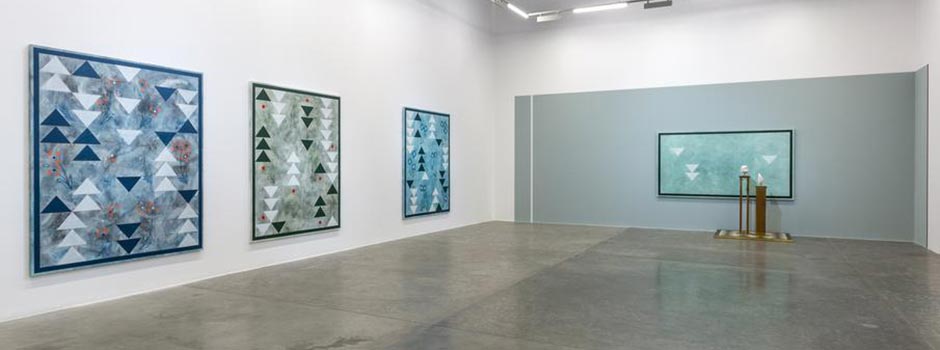
Solo Exhibition at the Green Art Gallery, Dubai (Nov 13, 2016 – Jan 15, 2017) Kamrooz Aram: Recollections for a Room
Dec 06, 2016 Exhibition

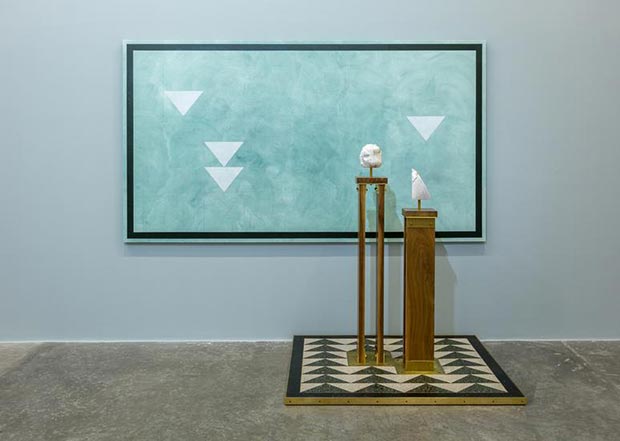 Kamrooz Aram, A Monument for Living in Defeat, 2016 / Canvas: Oil, wax and pencil on canvas, 152.4 x 274.32 cm / Tile Platform: Terrazzo and Brass on panel, 137.16 x 121.92 x 5.08 cm / Pedestals: Solid walnut and brass pedestals, 121.92 x 20.32 x 20.32 cm // 104.14 x 20.32 x 20.32 cm / Sculptures: Soapstone and alabaster, 17.78 x 16.51 x 15.24 cm // 20.32 x 10.16 x 15.24 cm / Courtesy of Green Art Gallery
Kamrooz Aram, A Monument for Living in Defeat, 2016 / Canvas: Oil, wax and pencil on canvas, 152.4 x 274.32 cm / Tile Platform: Terrazzo and Brass on panel, 137.16 x 121.92 x 5.08 cm / Pedestals: Solid walnut and brass pedestals, 121.92 x 20.32 x 20.32 cm // 104.14 x 20.32 x 20.32 cm / Sculptures: Soapstone and alabaster, 17.78 x 16.51 x 15.24 cm // 20.32 x 10.16 x 15.24 cm / Courtesy of Green Art Gallery
Aram’s paintings explore the potential for ornament and pattern to transcend the decorative. In these works, a pattern that has been built by repeating an isolated detail from a Persian carpet competes for dominance with a geometric pattern that one might associate with common European Modernist architecture. These paintings are made with a typically Modernist approach to painting: the artist works the entire canvas at once, building up and scraping down layers of paint, in search of a fleeting resolution. The paintings begin with a pencil grid, mapping out the floral forms, which are drawn in with oil crayons and then wiped away and redrawn, leaving evidence of the previous layers. The pencil grid emerges faintly to the surface, a nod to Agnes Martin, an artist that Aram has long admired. Like Martin, Aram is interested in an emotional or spiritual affect in his paintings, something that has frequently been deemed taboo in art criticism. Through the use of ornament and pattern, his paintings achieve a depth and presence beyond the so-called decorative, renegotiating a history of Modern art that has banished ornament as meaningless excess, a waste of labor, an architectural crime.
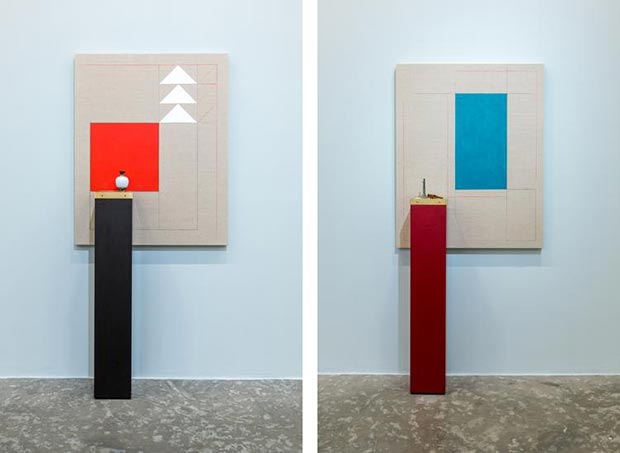 L. Kamrooz Aram, Ephesian Fog, 2016; Canvas: Acrylic, oil and pencil on linen, 127 x 101.6 cm; Pedestal: Wood and Brass pedestal, 22.86 x 22.86 x 127 cm; Object: Oil on ceramic (vase),13.97 x 7.62 cm / R. Kamrooz Aram, Reluctant Descent, 2016; Canvas: Oil and pencil on linen, 127 x 101.6 cm; Pedestal: Wood and Brass pedestal, 22.86 x 22.86 x 127 cm; Objects: Bronze and Iron objects, 13.97 x 11.43 cm / Courtesy of Green Art Gallery
L. Kamrooz Aram, Ephesian Fog, 2016; Canvas: Acrylic, oil and pencil on linen, 127 x 101.6 cm; Pedestal: Wood and Brass pedestal, 22.86 x 22.86 x 127 cm; Object: Oil on ceramic (vase),13.97 x 7.62 cm / R. Kamrooz Aram, Reluctant Descent, 2016; Canvas: Oil and pencil on linen, 127 x 101.6 cm; Pedestal: Wood and Brass pedestal, 22.86 x 22.86 x 127 cm; Objects: Bronze and Iron objects, 13.97 x 11.43 cm / Courtesy of Green Art Gallery
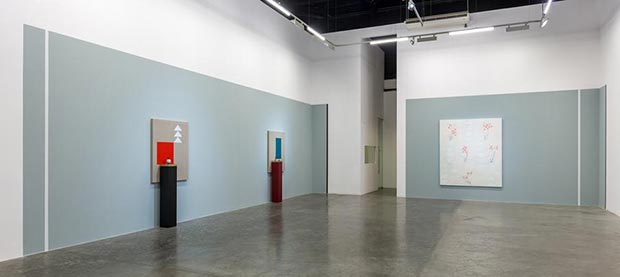 Installation view / Courtesy of Green Art Gallery
Installation view / Courtesy of Green Art Gallery
In addition to the paintings, Aram will debut a series of new sculptures exploring the significance of exhibition design in shaping our understanding of the antiquities we view in museums. For Aram, the manner in which these objects are displayed is as significant to creating meaning for the viewer as the objects themselves. Using architectural materials such as brass, hardwood planks and terrazzo, the artist creates works that focus as much on the formal qualities of design and display as they do on the objects displayed. These sculptural installations utilize paintings as backdrops, further examining the notion of the decorative in painting. The paintings have a dual role as both significant artworks in their own right and as passive backdrops to the displayed objects. The paintings, pedestals and objects in these works can only be viewed in relation to one another and never autonomously, depending on each other for context. Furthermore, the artist does not provide didactic text or wall labels identifying the displayed objects, challenging the viewer to disconnect them from a typical analysis of cultural significance, authenticity, authorship and provenance.
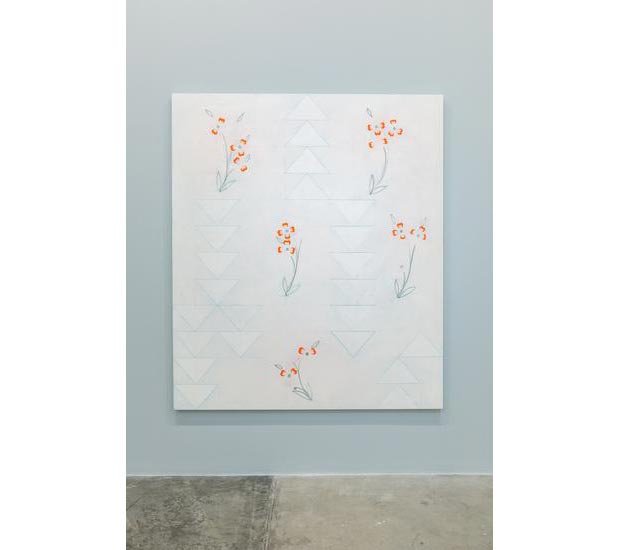 Kamrooz Aram, Ornament for a Quiet Room, 2016, Oil, wax and pencil on canvas, 213.36 x 182.88 cm / Courtesy of Green Art Gallery
Kamrooz Aram, Ornament for a Quiet Room, 2016, Oil, wax and pencil on canvas, 213.36 x 182.88 cm / Courtesy of Green Art Gallery
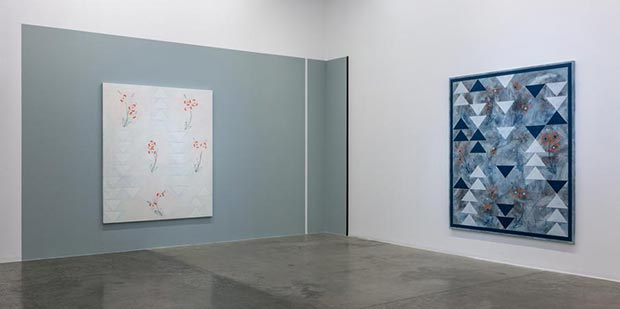 Installation view / Courtesy of Green Art Gallery
Installation view / Courtesy of Green Art Gallery
Kamrooz Aram (born 1978, Shiraz) received his MFA from Columbia University in 2003. Recent and upcoming solo exhibitions include: Museum Dhondt-Dhaenens, Belgium (forthcoming 2017); Recollections for a Room, Green Art Gallery, Dubai (forthcoming 2016); Palimpsest: Unstable Paintings for Anxious Interiors at Green Art Gallery, Dubai (2014); Negotiations at Perry Rubenstein Gallery, New York, New York (2011); Generation After Generation, Revolution after Revelation at LA> Select group exhibitions include: The Arch of my Eyes Orbit, Brooklyn Academy of Music, Brooklyn, NY (2016); The Worlds Turned Upside Down, BPS22, Brussels, Belgium (2015); Russian Doll, M+B, Los Angeles, USA (2015); Geometries of Difference: New Approaches to Ornament and Abstraction, The Samuel Dorsky Museum of Art at the State University of New York at New Paltz, New York (2015); Beauty Reigns: A Baroque Sensibility in Recent Painting, Akron Art Museum, Akron, OH (2015) and McNay Art Museum, San Antonio, TX (2014); Kamrooz Aram/Julie Weitz at The Suburban, Chicago, Illinois (2013); Brute Ornament: Kamrooz Aram and Seher Shah, curated by Murtaza Vali, at Green Art Gallery, Dubai, UAE (2012); The Elephant in The Dark, The Devi Art Foundation, Delhi (2012); roundabout, City Gallery Wellington, New Zealand (2010); the Busan Biennale, (2006); P.S.1/MoMA’s Greater New York 2005; and the Prague Biennale I (2003). Aram is the winner of the Abraaj Group Art Prize 2014; he has also been awarded grants from the New York Foundation for the Arts (2004) and the Jacob K. Javits Fellowship Program (2001-2003). His work is in the collections of The Metropolitan Museum of Art, New York; M+ Museum, Hong Kong; Cincinnati Art Museum, Ohio; The FLAG Foundation, New York; and Deutsche Bank Collection among others. Aram’s practice has been widely featured and reviewed in publications such as The New York Times, Art in America, Artforum.com, ArtAsiaPacific, The New Yorker, The National and Bidoun. He lives and works in Brooklyn, NY._2016.jpg) Kamrooz Aram, Ornamental Composition for Social Spaces (3), 2016, Oil, wax and pencil on canvas, 228.6 x 198.12 cm / Courtesy of Green Art Gallery
Kamrooz Aram, Ornamental Composition for Social Spaces (3), 2016, Oil, wax and pencil on canvas, 228.6 x 198.12 cm / Courtesy of Green Art Gallery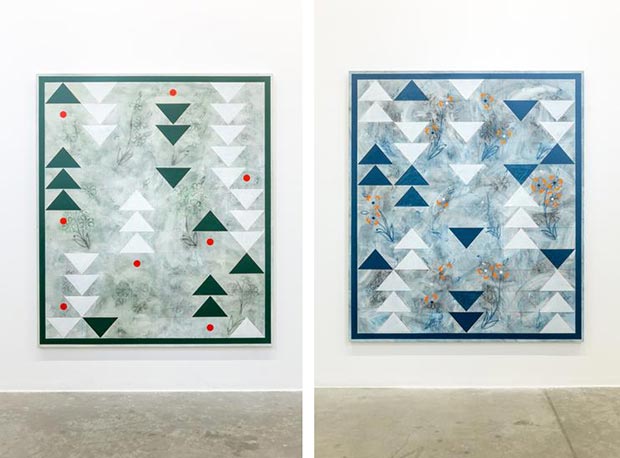 L. Kamrooz Aram, Ornamental Composition for Social Spaces (1), 2016, Oil, wax and pencil on canvas, 228.6 x 198.12 cm / R. Kamrooz Aram, Ornamental Composition for Social Spaces (2), 2016, Oil, wax and pencil on canvas, 228.6 x 198.12 cm / Courtesy of Green Art Gallery
L. Kamrooz Aram, Ornamental Composition for Social Spaces (1), 2016, Oil, wax and pencil on canvas, 228.6 x 198.12 cm / R. Kamrooz Aram, Ornamental Composition for Social Spaces (2), 2016, Oil, wax and pencil on canvas, 228.6 x 198.12 cm / Courtesy of Green Art Gallery
Comments
Add a comment